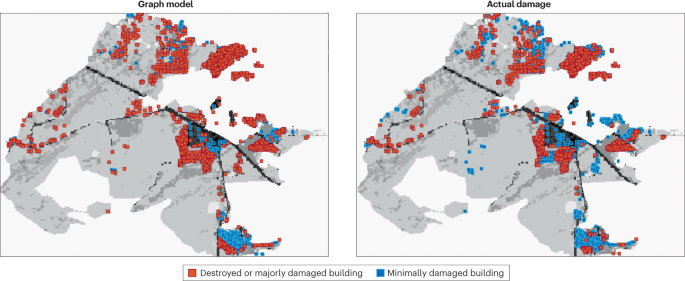
Capturing building vulnerability to wildfires with graph theory
- Select a language for the TTS:
- UK English Female
- UK English Male
- US English Female
- US English Male
- Australian Female
- Australian Male
- Language selected: (auto detect) - EN
Play all audios:
Access through your institution Buy or subscribe Wildfires are increasingly threatening the built environment, which is heterogenous and has a range of fuels not encountered in wildlands,
leading to different propagation patterns. There is need for comprehensive modelling techniques to determine vulnerability of the built environment to fire, but many wildfire modelling
approaches do not adequately capture these dynamics. Some physics-based models, such as computational fluid dynamics, are more promising, but require excessive computational resources,
making their application difficult in practice. The ability to capture damage to the built environment supports effective mitigation strategies and enables sustainable and equitable urban
planning so that communities can be made resilient to wildfires. For example, graph theory-based models are able to predict some of the building damage that occurred during the 2022 Marshall
Fire in Boulder, CO, USA, suggesting they will be useful in predicting building vulnerability in future events. This is a preview of subscription content, access via your institution ACCESS
OPTIONS Access through your institution Access Nature and 54 other Nature Portfolio journals Get Nature+, our best-value online-access subscription $32.99 / 30 days cancel any time Learn
more Subscribe to this journal Receive 12 digital issues and online access to articles $119.00 per year only $9.92 per issue Learn more Buy this article * Purchase on SpringerLink * Instant
access to full article PDF Buy now Prices may be subject to local taxes which are calculated during checkout ADDITIONAL ACCESS OPTIONS: * Log in * Learn about institutional subscriptions *
Read our FAQs * Contact customer support AUTHOR INFORMATION AUTHORS AND AFFILIATIONS * Department of Civil and Environmental Engineering, Colorado State University, Fort Collins, CO, USA
Akshat Chulahwat Authors * Akshat Chulahwat View author publications You can also search for this author inPubMed Google Scholar CORRESPONDING AUTHOR Correspondence to Akshat Chulahwat.
ETHICS DECLARATIONS COMPETING INTERESTS The author declares no competing interests. RIGHTS AND PERMISSIONS Reprints and permissions ABOUT THIS ARTICLE CITE THIS ARTICLE Chulahwat, A.
Capturing building vulnerability to wildfires with graph theory. _Nat Rev Earth Environ_ 4, 600 (2023). https://doi.org/10.1038/s43017-023-00426-9 Download citation * Published: 28 April
2023 * Issue Date: September 2023 * DOI: https://doi.org/10.1038/s43017-023-00426-9 SHARE THIS ARTICLE Anyone you share the following link with will be able to read this content: Get
shareable link Sorry, a shareable link is not currently available for this article. Copy to clipboard Provided by the Springer Nature SharedIt content-sharing initiative